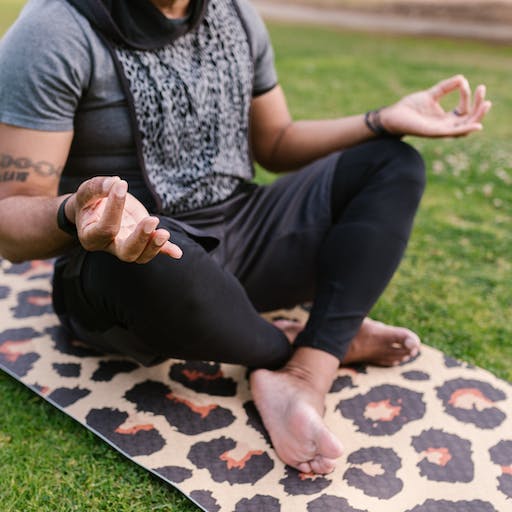Mandala meditation, a practice steeped in ancient traditions, has garnered significant popularity in our contemporary world. As we maneuver through the tumult of our daily lives, the quest for a haven of mental peace becomes ever more vital. In this article, we delve into the enchanting realm of mandala meditation, examining its roots, advantages, techniques, challenges, and the profound influence it can wield on our overall well-being.
Mandala meditation offers a pathway to inner peace, allowing individuals to connect with an age-old tradition that transcends the hustle and bustle of modern life. Originating from diverse cultural and spiritual backgrounds, mandalas serve as intricate tools guiding practitioners toward a heightened state of mindfulness.

Exploring the Origins of Mandala Meditation
Mandalas, derived from the ancient Sanskrit term meaning "circle," hold symbolic significance across various cultures, including Hinduism and Buddhism. The intricate geometric patterns of mandalas serve as focal points during meditation, fostering unity, harmony, and a sense of spiritual interconnectedness.
Techniques and Challenges in Mandala Meditation
Choosing or creating a mandala serves as the first step in this transformative journey. Whether opting for traditional cultural mandalas or crafting personalized ones, practitioners can tailor their experience to align with their preferences. However, challenges such as distractions and the initial learning curve may pose obstacles for beginners.
Transformational Impact on Well-being
Scientific studies underscore the positive impact of mandala meditation on mental and emotional well-being. Reduced anxiety, improved mood, and increased emotional resilience are among the documented benefits, highlighting the practice's transformative potential.
In conclusion, the ancient practice of mandala meditation offers a refuge of tranquility amidst the chaos of modern life. By exploring its origins, embracing its benefits, and navigating through techniques and challenges, individuals can unlock the transformative impact it has on their overall well-being. Incorporating mandala meditation into one's routine serves as a timeless and accessible tool for achieving inner peace and fostering a balanced and centered life.
This exploration into the captivating world of mandala meditation showcases its relevance in our fast-paced lives and the potential it holds for those seeking a profound connection with their inner selves.
I. Introduction
In the fast-paced rhythm of contemporary life, where stress and distractions abound, mandala meditation emerges as a beacon of tranquility. Derived from ancient spiritual practices, this form of meditation employs the use of intricate geometric patterns to guide individuals into a state of profound inner calm. Let's delve into the essence of mandala meditation and understand why it has become a go-to practice for many seeking serenity.
II. Understanding Mandala Meditation
Defining Mandalas:
A mandala, a term derived from Sanskrit, translates to "circle" and holds symbolic significance across various cultures. In the context of meditation, mandalas represent a visual aid to concentration, leading practitioners toward a heightened state of awareness.
Origin and Purpose:
Mandalas have a rich history, originating in diverse cultures such as Hinduism and Buddhism. Used as spiritual symbols, these intricate designs serve the purpose of focusing the mind during meditation, promoting a sense of unity and harmony.
III. Benefits of Mandala Meditation
Stress Reduction:
Engaging with mandalas in meditation proves to be a powerful stress-reduction technique. The rhythmic and repetitive nature of focusing on the intricate patterns induces a meditative state, calming the nervous system and alleviating stress.
Enhanced Focus:
As the mind becomes absorbed in the details of a mandala, concentration is heightened. This enhanced focus transcends the meditation session, improving overall concentration and cognitive abilities in daily tasks.
IV. How to Practice Mandala Meditation
Choosing or Creating a Mandala:
Whether selecting a pre-designed mandala or creating a personalized one, the choice is personal. Some find resonance in traditional patterns, while others explore their creative side by crafting unique designs.
Creating the Right Environment:
To optimize the meditative experience, establish a quiet and comfortable space. Dim lighting, soothing music, and minimal distractions contribute to a conducive environment for mandala meditation.
Techniques for Meditation:
Guided visualization and mindful breathing are common techniques used in mandala meditation. By syncing breath with the intricate details of the mandala, practitioners enter a state of deep meditation.
V. Exploring Various Mandalas
Traditional Cultural Mandalas:
Across cultures, mandalas carry unique cultural meanings. Tibetan Buddhism, for instance, features intricate sand mandalas created as a form of meditation and impermanence.
Personalized Mandalas for Meditation:
Creating a personal mandala adds a touch of individuality to the practice. This could involve drawing, coloring, or even digitally designing a mandala that resonates with personal symbolism.
VI. Integrating Mandala Meditation into Daily Life
Incorporating Short Sessions:
Mandala meditation need not be time-consuming. Short, focused sessions can be seamlessly integrated into a busy schedule, offering moments of respite amid daily chaos.
Combining with Other Mindfulness Practices:
Enhance the benefits of mandala meditation by combining it with other mindfulness practices. Incorporating mindful walking or breathing exercises complements the calming effects of mandala meditation.
VII. Scientific Perspective on Mandala Meditation
Research Studies on Benefits:
Scientific studies affirm the positive impact of mandala meditation on mental well-being. Reduced anxiety, improved mood, and enhanced cognitive functions are among the documented benefits.
Impact on Mental and Emotional Well-being:
Beyond stress reduction, mandala meditation contributes to emotional balance. Regular practice has been linked to increased emotional resilience and a more positive outlook on life.
VIII. Common Challenges in Mandala Meditation
Dealing with Distractions:
Distractions are inevitable, especially for beginners. Acknowledging distractions without judgment and gently refocusing on the mandala helps cultivate resilience against interruptions.
Overcoming the Learning Curve:
For those new to mandala meditation, the intricate patterns may initially pose a challenge. Patience and consistent practice gradually alleviate the learning curve, making the experience more fluid.
IX. Success Stories
Real-life Experiences:
Countless individuals have witnessed transformative experiences through mandala meditation. Testimonials highlight improved sleep, reduced stress, and a profound sense of inner peace.
Positive Transformations:
Stories of individuals discovering newfound clarity and resilience through mandala meditation serve as inspiration for those embarking on their journey.
X. Tips for a Successful Mandala Meditation Practice
Consistency is Key:
Regular and consistent practice is fundamental for reaping the full benefits of mandala meditation. Establishing a routine fosters a sense of discipline and reinforces the meditative habit.
Adjusting the Practice:
Recognize that each individual's journey is unique. Adjust the duration and intensity of mandala meditation based on personal needs and evolving comfort levels.
XI. Frequently Asked Questions (FAQs)
Q1: Can anyone practice mandala meditation, regardless of experience?
Absolutely! Mandala meditation is suitable for beginners and experienced meditators alike. The flexibility of the practice accommodates various skill levels.
Q2: How long should a typical mandala meditation session last?
The duration can vary, but starting with 10-15 minutes is recommended for beginners. Advanced practitioners may extend sessions based on personal preferences.
Q3: Is there a specific time of day that's best for mandala meditation?
While there's no strict rule, many find mornings or evenings conducive to meditation. Choose a time that aligns with your daily rhythm and allows for a relaxed environment.
Q4: Can mandala meditation be combined with other meditation techniques?
Certainly! Many individuals blend mandala meditation with other techniques, such as mindfulness or mantra meditation, for a more comprehensive practice.
Q5: How soon can one expect to experience the benefits of mandala meditation?
The timeline varies, but consistent practice often yields noticeable benefits within a few weeks. Individual experiences may differ, so patience is key.
XII. Exploring Advanced Mandala Meditation Techniques
Beyond Basic Practices:
For those seeking to deepen their meditative experience, advanced techniques such as chakra-focused mandala meditation or dynamic mandala visualization can offer new dimensions of self-discovery.
Deepening the Meditative Experience:
Exploring advanced techniques involves delving into the symbolism of mandalas and cultivating a deeper connection with the spiritual aspects of meditation.
XIII. Sharing the Joy of Mandala Meditation
Building a Community:
Mandala meditation need not be a solitary pursuit. Joining or forming a community of like-minded individuals creates a supportive environment for shared experiences and growth.
Encouraging Others:
Share the joy of mandala meditation with friends and family. Hosting workshops or introducing the practice to others can foster a sense of connection and well-being within the community.
XIV. Conclusion
In conclusion, mandala meditation offers a profound journey into self-discovery and tranquility. From its rich cultural roots to the scientifically proven benefits, this practice has the potential to transform lives. Whether you are a seasoned meditator or a curious beginner, the captivating world of mandala meditation invites you to explore inner realms and embrace a path of mindfulness.
Remember, the journey is personal, and with consistent practice, the intricate patterns of mandala meditation weave a tapestry of peace and well-being.
FAQs: Unlocking the Mysteries of Mandala Meditation
Q1: Can anyone practice mandala meditation, regardless of experience?
Absolutely! Mandala meditation is suitable for beginners and experienced meditators alike. The flexibility of the practice accommodates various skill levels.
Q2: How long should a typical mandala meditation session last?
The duration can vary, but starting with 10-15 minutes is recommended for beginners. Advanced practitioners may extend sessions based on personal preferences.
Q3: Is there a specific time of day that's best for mandala meditation?
While there's no strict rule, many find mornings or evenings conducive to meditation. Choose a time that aligns with your daily rhythm and allows for a relaxed environment.
Q4: Can mandala meditation be combined with other meditation techniques?
Certainly! Many individuals blend mandala meditation with other techniques, such as mindfulness or mantra meditation, for a more comprehensive practice.
Q5: How soon can one expect to experience the benefits of mandala meditation?
The timeline varies, but consistent practice often yields noticeable benefits within a few weeks. Individual experiences may differ, so patience is key.
FIND MORE AT https://www.inner-guide.com/mandalas-for-inner-peace/


